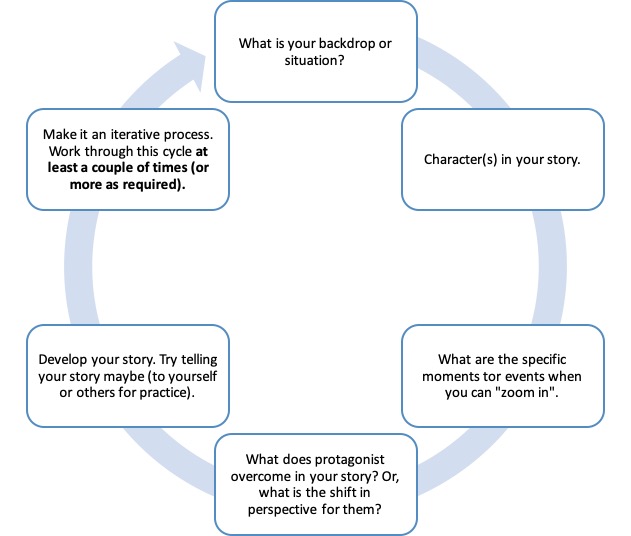When you are working on your story, write down your thoughts. It can be your first cut at the story as it flowed for you intuitively, or your notes compiled as a series of bullet points, or any other way that ideas emerge.
Write it down without worrying about the final structure and flow.
Keep an open mind in the early phase of your story development. Let the juices flow and ideas emerge for you.
Once you have it, take a step back and think about your story using the following steps.
STEP # 1: A story has a situation, or a context, or a backdrop. What is that in your account?
STEP # 2: Identify the character(s) you want to include in your story.
- If it is your personal story, you are one of the characters in it.
- Or else, characters can be other people.
STEP # 3: The protagonist in the story overcomes something or someone or has a shift in perspective. It changes them in some way. What is that in your account?
- If it is a personal story, it is you that changes. How did the story change you?
- The protagonist in your story can also be someone else. In that case, how did he or she change from inside in your account? What is the impact of that to you personally, or what makes it an intriguing story to tell for you?
STEP # 4: Story should have a shift, a variation, a twist, or a surprise.
There is a rising action that leads to a climax in your story.

The in the diagram above shows a gradual build-up in the story leading to a climax.
The shows a protagonist going through what starts as a routine day or a circumstance. However, a surprise or a shocking situation arises, or a bad guy shows up leading to the dip. He or she recovers, and life goes back to normal. In the process, though, the protagonist has a new perspective or mindset from the experience of the story.
A in the diagram can be a positive or negative emotion that a protagonist goes through in your account. Life could be going okay, and then an event leads to a significant spike, while figuring the way around, they find that emotion to be way down towards the end of the story. Is the protagonist happier or sadder at the end of the story? It can be either way, depending on your story account.
NOTE: These are just three examples; the variations can be in any pattern for your story. The takeaway here is that your storyline plot should have ups and downs to pull in the audience.
STEP # 5: A story should have events or specific moments that move it forward.
What are specific moments or experiences or incidences that have made a strong impression on you?
Zoom in to those moments while developing your story. “Take” your audience there, make them feel, and see and hear what you did in those instances.
Three steps:
- Think about it and select these moments to share.
- Develop each of these using vivid descriptive language, or dialogs, or specific details, etc.
- Practice delivery of these zoom-in moments. Invite your audience in, let them see and feel what you experienced emotionally. The practice is critical to your success with it.
Is your story about someone else? Is it derived from a book or a movie? If so:
- Which is (are) the character(s) that appealed to you the most? Develop a story from their perspective.
- You can and probably will have an entirely different perspective and message than others, even if you got the inspiration for your story from the same book, movie, or a current event.
STEP # 6: Develop your narration or plot, stringing together the events you captured in step # 5.
Use at least a couple of iterations of steps # 2-6 to refine your story. Sometimes, when you try to tell your story, ideas can galvanize for you as well. Use our regular meeting to practice it once maybe, and use that to go back and revise the story.

STEP # 7: Practice delivery of zoom-in moments.
Use your vocal variety, facial expressions, and body language when you speak. The use of dialogs, vivid descriptive details, etc. can make a huge difference when you slow it down and let your audience feel those.
The practicing is critical to your success with it—PRACTICE, PRACTICE, PRACTICE.
Click here to download a printable (.PDF) version of this (opens in a new window or tab).
